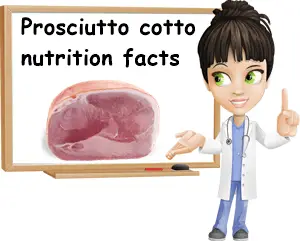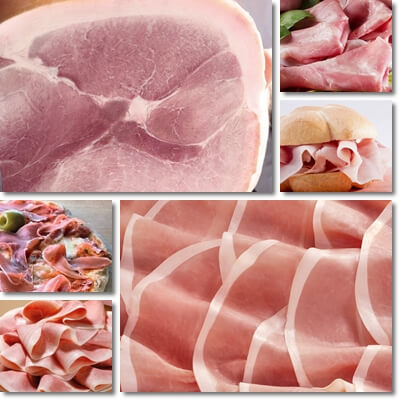Prosciutto cotto is a specialty Italian ham made from salt-cured and cooked pig back leg. It is a delicate-tasting and flavorful deli meat with good nutrition. Prosciutto cotto is a source of vitamin B12 and contains good amounts of vitamins B1, B2, B3 and B6, but also phosphorus, potassium, choline, copper, selenium and zinc. At the same time, it is a source of histamine, nitrites and saturated fat and high in sodium.
While a source of several wonderful benefits, prosciutto cotto is not entirely healthy and can cause side effects such as high blood pressure, indigestion or acid reflux at night.
Prosciutto cotto vs crudo
Prosciutto cotto and crudo are essentially different variants of the same type of ham. Both are made from pig back leg, with the top part being the actual ham. The difference is prosciutto cotto uses only the top part of the pig back leg and is deboned, versus crudo which uses either the whole pig leg, with bone, or only the top part, also with bone.
Another important difference: prosciutto cotto is salt-cured and cooked, vs crudo which is salt-cured, air-dried and aged (for 1-3 years). The difference is in the name: cotto is cooked (‘cotto’ means cooked in Italian), whereas crudo is raw, uncooked (‘crudo’ means raw in Italian). Read more about the difference between prosciutto crudo vs cotto.

Prosciutto cotto properties
- The following are the characteristic properties of original Italian prosciutto cotto:
- Pure pork meat, made entirely from the top part of pig hind legs.
- Deboned, degreased, with tendons and rind removed.
- Minimally processed: salted (brined), seasoned, pressed (in a mold) and cooked (steam-cooked).
- Contains nitrites and nitrates, but low amounts (vs crudo which is preservative-free).
- Sugar-free and gluten-free.
- High-sodium (the ham soaks up salt during the brining process).
- Humidity ranges from 75.5% – 76.5% in high-quality prosciutto cotto to 81%-82% in lesser quality prosciuttos.
Note: Preservatives and additives in prosciutto cotto may include the following: E450, E459, E620, E629, E251, E252, E249, E250, E309, E300 etc. Higher-quality prosciuttos typically have very few additives and only small amounts of them, whereas lower-quality prosciuttos, aka regular hams, are higher in additives. Also see What is prosciutto cotto?
Prosciutto cotto nutrition facts
The exact nutritional values of prosciutto cotto range from ham to ham. This is because there isn’t just one type of prosciutto cotto or one recipe, and the nutritional value of the main raw material used, the pork meat, ranges according to the pig’s diet, species and other factors. This being said, prosciutto cotto is:
- High-sodium: 1200 – 2700 g of sodium/100 g
- High-protein (around 20 g of protein/100 g)
- Fat content between 8 g – 20 g/100 g
- Saturated fat content 3 g – 8 g/100 g
- Cholesterol content at 70 mg/100 g
- Source of EPA and DHA Omega-3 fatty acids
- Moderate energetic value (around 200-275 kcal/kilocalories per 100 g)
- Good source of vitamins B1, B2, B3, B6, but low in vitamin B9 (folate)
- Good source of vitamin B12
- Good source of choline, copper, phosphorus, potassium, selenium and zinc, but low in calcium and magnesium
- Contains trace amounts of vitamins E and D
- No vitamin A, no vitamin C, no vitamin K
- No fiber, trace amounts of carbohydrates
- Sugar-free

Benefits of prosciutto cotto
- Good source of vitamins B1, B2, B3, B5, B6, B12, prosciutto cotto boosts energy levels.
- Source of vitamin B12 and iron for red blood cell production, prosciutto cotto restores vitality.
- Anti-anemia food – combats tiredness, fatigue, muscle weakness, apathy.
- Source of EPA and DHA Omega-3 fatty acids – anti-inflammatory benefits for the cardiovascular system.
- Brain food – source of fat, especially healthy Omega-3, and protein, prosciutto cotto nourishes the brain and supports cognitive functions.
- Potential benefits for delaying cognitive decline thanks to vitamin B12 and cholesterol which help make up the myelin sheath, the protective coating surrounding the tail of nerve cells.
- Potential benefits for mental health – studies show EPA and DHA Omega-3 fatty acids have positive effects for anxiety and depression and can help improve mood.
- High in protein – the amino acids that make up protein help make neurotransmitters for the nervous system that regulate mood, appetite, sleep and more.
- High in protein and contains all essential amino acids and non-essential amino acids – contributes to muscle mass, helps build and repair damaged muscle.
- Benefits for skin thanks to Omega-3 and other fats which are physically part of cell membranes and help cells retain moisture for healthy-looking, radiant skin.
- Source of selenium, prosciutto cotto is good for thyroid health and, as a result, also holds benefits for fertility and metabolism.
- Source of calcium, magnesium and especially phosphorus – has benefits for bone and teeth health.
- High-protein and a source of fat, but sugar-free and almost carbohydrate-free, prosciutto cotto is very low glycemic-index and doesn’t raise blood sugar levels.
- Minor benefits for the immune function thanks to zinc and other nutrients.
What are the side effects of Prosciutto Cotto?
The side effects of prosciutto cotto are directly proportional with intake and frequency of consumption and may include:
- Indigestion, acid reflux. Some people may find prosciutto cotto too heavy on the stomach, especially if eaten at night, and experience indigestion with symptoms such as nausea, stomach pain, or acid reflux with symptoms such as regurgitation of stomach contents, heartburn, acidic burping, acid reflux at night, interrupted sleep etc.
- Higher cancer risks. According to recent studies, a frequent and significant intake of red meat and processed luncheon meats raises risks of several cancers, including colon and stomach cancer. Prosciutto cotto is a pork-based luncheon meat, and contains preservatives, nitrites and nitrates; as a result, it is best consumed in limited amounts. A limited, infrequent intake should pose no significant long-term health risks.
- High blood pressure. Prosciutto cotto is high-sodium – as little as 100 g may contain anywhere between 1.2 and 2.7 g of salt (the maximum recommended daily intake of sodium/salt is 2.3 g for a healthy adult). Eating too much or having it too frequently can cause an excessive intake of sodium, above advised dietary recommendations, and lead to side effects such as high blood pressure, higher risks of cardiovascular events, water retention, face puffiness, swollen arms, hands and swollen ankles and legs.
- Source of histamine. Histamine is a neurotransmitter and a key-agent in immune system-related responses, mediating inflammatory reactions and itching responses, and plays a part in vasodilation and secretion of stomach acid, among other functions. It is commonly found in generous amounts in several foods, but pork meat and pork-based products such as prosciutto cotto and other hams are important sources. An intolerance to histamine can cause a series of side effects affecting multiple systems.
- Source of saturated fat. Saturated fat in general is not healthy for the heart and vascular system which means prosciutto cotto is best eaten reasonably and preferably also infrequently.
